The rain eased off, day by day, until it only fell in the afternoons. The mornings were bright and hot, and dried the road quickly. I decided that the optimal time to leave would be about ten or eleven in the morning: maximal drying time for the boggy sections, whilst leaving enough time to get down the mountain before the heavens opened again.
By the time we set about repacking my panniers, I had only two full days left on my visa; the day after tomorrow, I had to be out of Timor Leste. Having never gotten my phone back, I had no maps and no idea which roads to take. Even assuming that I found the border crossing easily enough, I wasn’t sure where I’d next be able to get my hands on a budget smartphone once I crossed the Indonesian border. Ultimately, not having any maps made me feel vulnerable, and it wasn’t a feeling that I liked. So I decided that I would go back to Dili first, buy a smart phone, and then make a break for the border from there.
If I could make it out of the mountains and onto the main road from Maliana, I figured that navigation should be easy enough: head North until I hit the coast, then turn and ride east until I hit Dili. Having ridden through Dili once and crossed it twice in a taxi cab, I was pretty sure I remembered the layout of the city. If I could find the big statue of Nicolas Lobato in the middle of the roundabout on the western edge of town, I reckoned I could navigate from there.
So it was time to say goodbye to my friends. Isa brewed sweet black Timorese coffee and poured it into a clean bottle, for me to drink along the way. Whenever someone cares enough to pack me a snack – to think about my future comfort and take steps to secure it – it makes me feel outrageously loved.
Everyone helped me gather my gear and pack up, and in passing Betty demonstrated to me the surprising strength of the hard-working Timorese woman. Slim in build and about half my size, Betty used one hand to pass me the pannier that I always have to heft with two. Who needs crossfit.
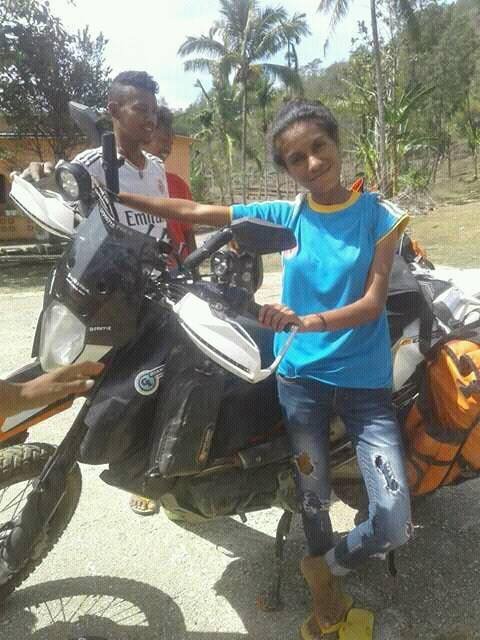
My gorgeous friend Betty. She’s stronger than she looks! Go girl!
Meanwhile the boys horsed around on Beastie. It was so hard to say goodbye. My rather stressful and scary introduction to Morobo – characterised by the midnight machete man and the theft of my phone – had turned into a surprising rural idyll with friends.
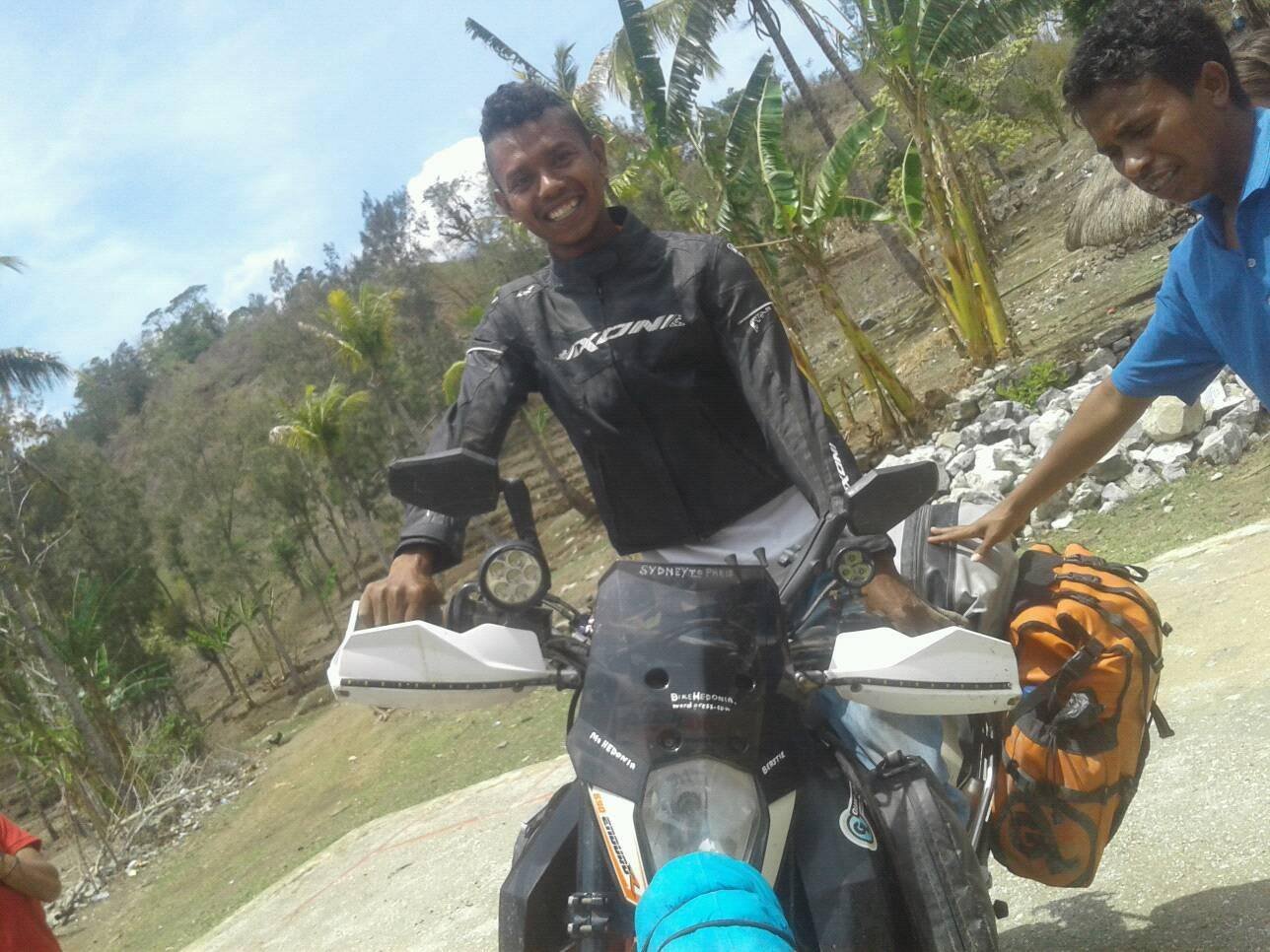
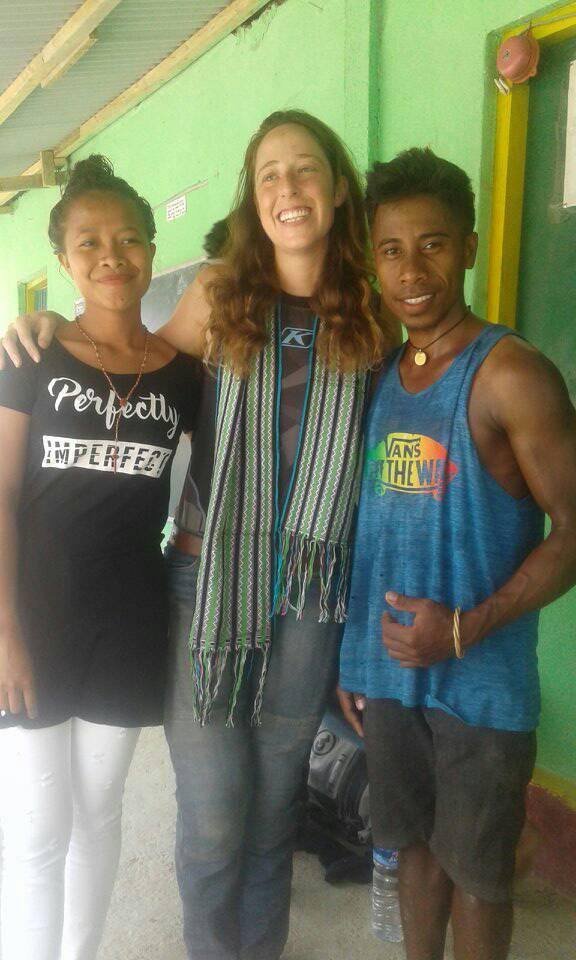

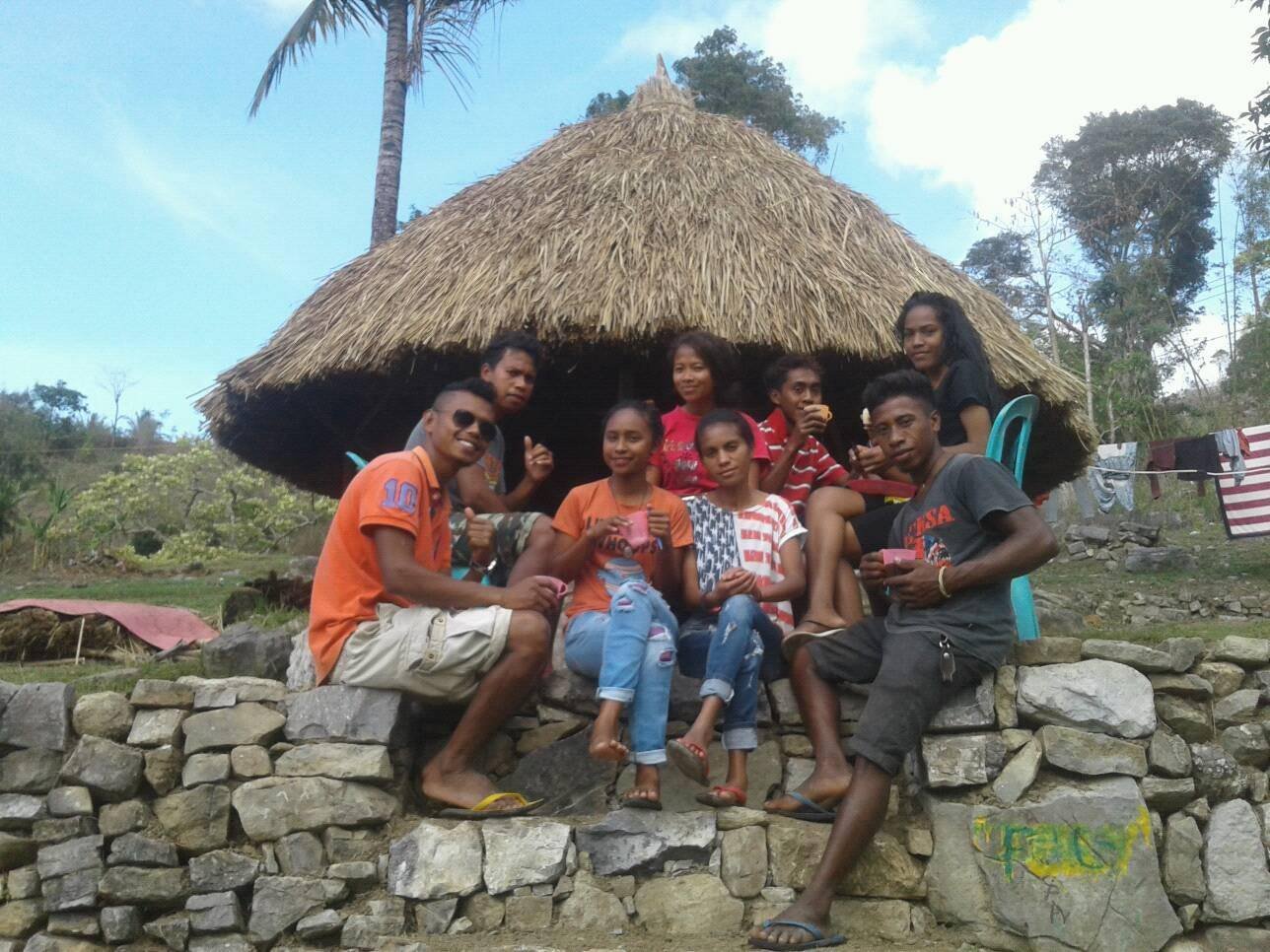
The shade shelter, reconstructed to glorious effect after the rains. Photo credits and my unending gratitude to all of you.
But soon, we were off. Mockhy and Sena rode with me to the nearest turn-off to Bonbonaro, and then I was on my own.
[youtube https://www.youtube.com/watch?v=tbrGjYwvJxw&w=560&h=315]
It was just another beautiful day’s riding on Timor’s lovely, dodgy dirt roads. After ten or fifteen minutes, I came across a policeman blocking the road with his motorbike. He flagged me down, and said something about Australians while pointing up the road. How odd; how did he know I was Australian? And what was the issue with the road? After a bit of arm waving it seemed that I was fine to proceed, but that I should look out for some undefined Australian hazard.
Mystified, I continued on, and soon things became clear: first I heard sirens, then I saw police vehicles and then I saw the convoy. A string of white Landcruisers crawled along the track, flying little Australian flags on their bonnets. I saw three or four curious white faces pass by in the passenger seats. Some kind of official visiting delegation being taken on a pleasure outing to the hot springs in between the serious work of bartering aid for natural resources, perhaps? There were ten, maybe a dozen four wheel drives in the procession, and I watched this incongruous concentration of resources snaking its way across the barren hilltop.
I got to the tiny cluster of shops that was Bobonaro, and took the only road out of the three that I hadn’t taken before. I’d already come from Suai, and I’d gone to Marobo, so the remaining road must take me to Maliana.
It was a good bet, and after half an hour of pleasingly awful road conditions, I was on asphalt, rolling through villages, rolling through a town. This must be Maliana. I had to stop once, at an intersection, and ask the way to Dili; curious locals were quick to point me down the road. Obrigada, obrigada. Thank you.
I passed the town ‘bus station’ which was crowded with clapped out vans. One of my friends from Marobo was also travelling to Dili today, by minibus. She had left at 4am that morning, and would not get to Dili 6pm that night; fourteen hours in two or three heinously overcrowded vans, whereas here I was, cruising along in my Shoei helmet and my crazy-unfair white person privilege.
I wished I could have taken her to Dili too, but with all my gear on Beastie there was no spare real estate for an extra passenger or luggage. I was also, frankly, not confident in my ability to safely navigate some of the off-road ‘road’ conditions further up the mountain with a passenger; I’m happy enough to take a few dirt naps, but what if I had a passenger and they got hurt? Still, I felt like a dick.
I stayed on the main road to the coast, even though I could feel it taking me north-west instead of north-east. Now was not the time to be taking short-cuts without a map. By the time I hit the coast and turned right, I thought I was probably almost at the border.
Now this was the best road in Timor Leste: asphalt, only broken in places, and often two vehicles wide. However, it was also by far the most dangerous road in Timor Leste once you factored in the suicidal speeding and swerving of clapped out four wheel drives. In a country without schedules, the speeding hardly seemed worth it. I mean, this might be the best road in Timor Leste, but that doesn’t mean that it isn’t blocked by fallen rocks the size of trucks (it is), or that the potholes in the new asphalt are not thirty centimetres deep (they are). I came across one procession vehicles travelling slowly; it turned out to be a funeral procession.
I stopped and bought sweet mangoes beside the road, five mangoes for fifty cents. I sat with the old women under the shady trees and peeled my mangoes with my sharp knife, juice running down between my fingers. They tasted like sunshine, the flesh firm and bright yellow beneath the green skin. I drank the coffee that Isa had packed for me earlier, and I was happy.
* * *
I knew I was getting close to Dili when I started to see people running along beside the road. Running for sport, you know? An unnecessary expenditure of athletic energy. You don’t see that in the countryside.
Then I started to see the clapped out, hotted up sedans parked at rubbish-littered scenic points by the sea. It was Sunday afternoon, and the people of Dili were out pleasure seeking. It felt a little nostalgic, like the early 1990s Australia I barely remembered, when people trundled around to scenic spots on the weekend, slightly bored but not admitting to it. Or maybe it was just the cars that made me feel that way: Skylines, Corollas, Datsuns from the 70s and 80s.
Then I saw a petrol station, a traffic jam. Positively cosmopolitan. This must be Dili. I fought my way through evening markets encroaching on the road and kept riding, riding, riding. Suddenly, the statue! There was Nicolas Lobato, looming over the roundabout like my North Star, orienting me in the chaotic sprawl of Dili.
I saw the mall, but kept going. Now I was tired, dehydrated, and too short-tempered to think about which electronic device to purchase. I navigated unerringly back to the hostel where I’d stayed on my first night in Timor Leste: it was cheap enough by Dili standards, and I knew they had somewhere safe for the bike.
The owner saw me, and was immediately convinced that I was Elisa Wirkala. “You’re back!” He said. “You’re alive! Last time I saw you, you were really sick, and said you didn’t know if you could even ride! You look much better now!”
No, no, that wasn’t me, I tried to explain; but then again, all us women on motorbikes look the same.
Later on, I swapped storied with some interesting foreigners I found at the hostel: a UN nutritionist, working across shady parts of the world for some years; a Peace Corps volunteer; and a Canadian paramedic who’d just finished hiking up the most radical peak in Papua. I drank a beer, I ate a quesadilla with cheese, I spoke fast idiomatic English and was understood. These pleasures hit me with intensity. Timor was teaching me, again, to appreciate what I had.
The next day I procured the most budget smartphone I could find, and immediately overloaded the little device with maps downloaded through the hostel wifi. Then I took a photo of Beastie, hiding out around the back of the building in Dili.
We were back on track.
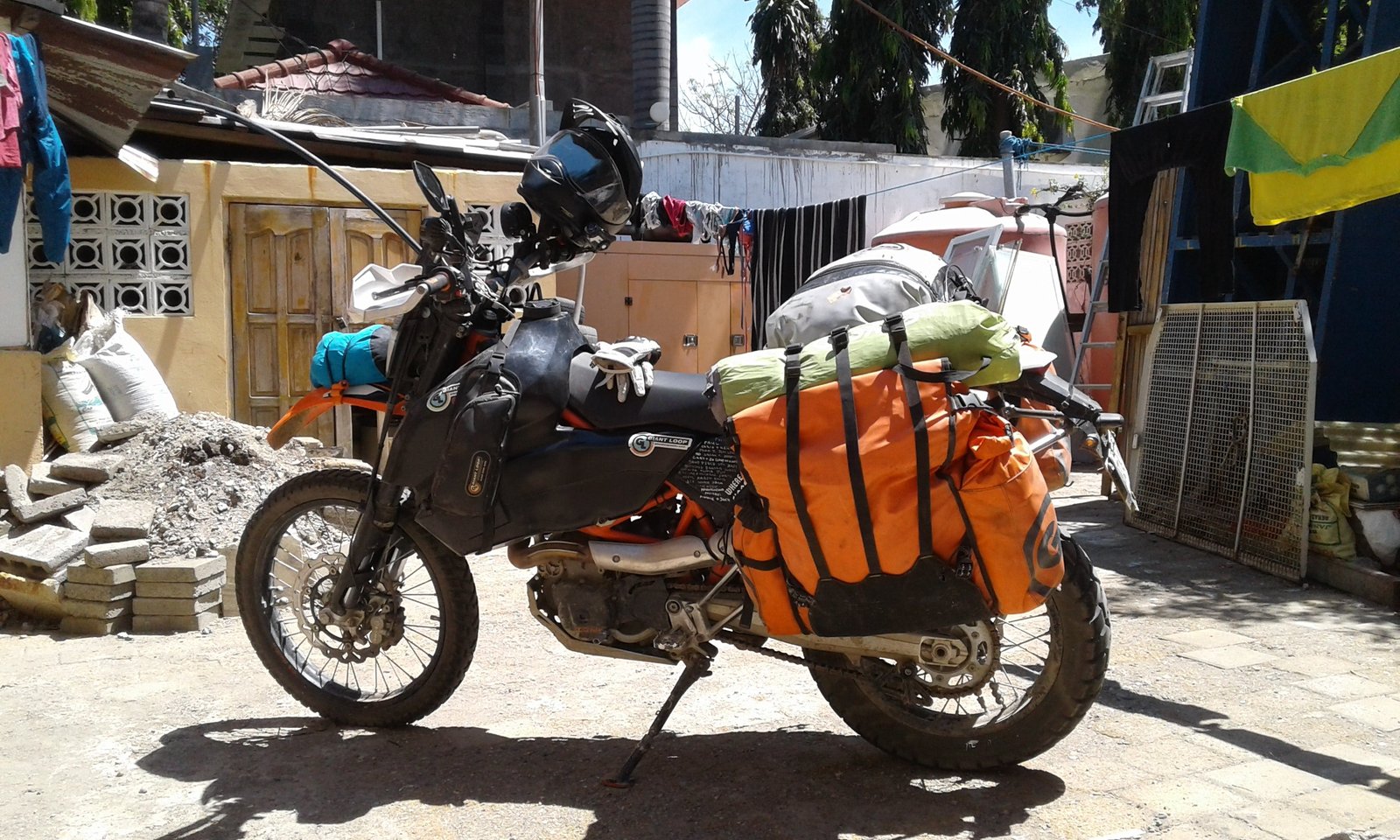

That’s such a bummer you never got your phone back. As you said, for loss of all the photos more than anything else… but you’ll always have the memories! (Or maybe since I’m still early in your blog, you somehow miraculously were reunited with your phone… hmmm… an intriguing possibility?)
I love your optimism